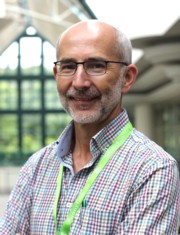Scientist profiles M-R
SRI profiles

Affiliate scientist
Odette Cancer Centre
Sunnybrook Health Sciences Centre
2075 Bayview Ave.
Toronto, ON
M4N 3M5
Administrative Assistant: Carol D'Souza
Phone: 416-480-6165
Email: carol.dsouza@sunnybrook.ca
Education:
- MB, BCh BAO, 1985, University College Cork, Ireland
- MRCPI, 1988, Royal College of Physicians of Ireland
- FFRRCSI, 1992, Royal College of Surgeons of Ireland
- FRCPC, 1994, Royal College of Physicians and Surgeons of Canada
Appointments and affiliations:
- Affiliate scientist, Evaluative Clinical Sciences, Odette Cancer Research Program, Sunnybrook Research Institute
- Radiation oncologist, Sunnybrook Health Sciences Centre
- Associate professor, department of radiation oncology, University of Toronto
Research foci:
- Brachytherapy
- Prostate cancer
- Image guidance
Research Summary:
The focus of Dr. Morton's research is the use of image-guided technology to guide interstitial radiotherapy of prostate cancer. He has developed novel methods of delivering high dose-rate (HDR) brachytherapy to treat prostate cancer through clinical research. These protocols have been widely adopted internationally and have set new standards for combining HDR brachytherapy and external beam radiotherapy to treat intermediate and high-risk prostate cancer. He is investigating optimal dose fractionation for HDR monotherapy using advanced imaging, and co-chairs a number of national and international randomized clinical trials on prostate cancer radiotherapy.
Selected publications:
See current publications list at PubMed.
- Shahid N, Loblaw A, Chung HT, Cheung P, Szumacher E, Danjoux C, Sankreacha R, Zhang L, Deabreu A, Mamedov A, Morton G. Long-term toxicity and health-related quality of life after single-fraction high-dose-rate brachytherapy boost and hypofractionated external beam radiotherapy for intermediate-risk prostate cancer. Clin Oncol (R Coll Radiol). 2017 Jul;29(7):412–20.
- Zaorsky NG, Davis BJ, Nguyen PL, Showalter TN, Hoskin PJ, Yoshioka Y, Morton GC, Horwitz EM. The evolution of brachytherapy for prostate cancer. Nat Rev Urol. 2017 Jun 30;14(7):415–39.
- Morris WJ, Tyldesley S, Rodda S, Halperin R, Pai H, McKenzie M, Duncan G, Morton G, Hamm J, Murray N. Androgen suppression combined with elective nodal and dose escalated radiation therapy (the ASCENDE-RT trial): an analysis of survival endpoints for a randomized trial comparing a low-dose-rate brachytherapy boost to a dose-escalated external beam boost for high- and intermediate-risk prostate cancer. Int J Radiat Oncol Biol Phys. 2017 Jun 1;98(2):275–85.
- Morton G, Chung HT, McGuffin M, Helou J, D’Alimonte L, Ravi A, Cheung P, Szumacher E, Liu S, Al-Hanaqta M, Zhang L, Mamedov A, Loblaw A. Prostate high dose-rate brachytherapy as monotherapy for low and intermediate risk prostate cancer: early toxicity and quality-of-life results from a randomized phase II clinical trial of one fraction of 19Gy or two fractions of 13.5Gy. Radiother Oncol. 2017 Jan;122(1):87–92.
- Batchelar DL, Chung HT, Loblaw A, Law N, Cisecki T, Morton GC. Intraoperative ultrasound-based planning can effectively replace postoperative CT-based planning for high-dose-rate brachytherapy for prostate cancer. Brachytherapy. 2016;15(4):399–405.
Related Links:


